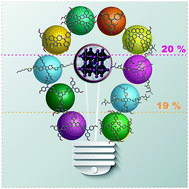Hole transporting materials for perovskite solar cells: a chemical approach
Abstract
Photovoltaic solar cells based on perovskites have come to the forefront in science by achieving exceptional power conversion efficiencies (PCEs) in less than a decade of research. This “still young” generation of solar cells is currently rivalling, in PCEs, well-established technologies, such as cadmium telluride (CdTe) and silicon. Further improvements in device stability by means of innovative materials are yet to come, with technology becoming closer to meeting the market requirements. Emerging from this groundbreaking discovery, a great number of charge transporting materials have flourished, which is particularly true for hole transporting materials (HTMs). The huge number of molecules prepared stem from design and engineering of a wide variety of new and also chemically modified old molecules where organic synthesis has played a fundamental role. In this review, the contribution of chemistry through those synthetic protocols used for producing new and innovative HTMs from relatively simple organic molecules is presented in a rational and systematic manner. The variety and impact of synthetic strategies followed, the structure–property relationship and stability, conductivity and device performance are highlighted from a chemical viewpoint.



 Please wait while we load your content...
Please wait while we load your content...